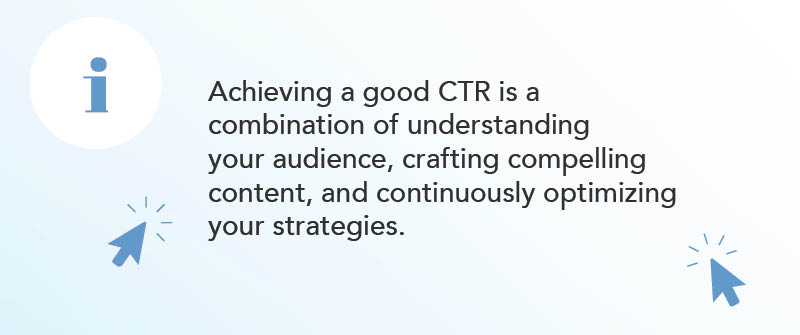AudiencePoint is thrilled to announce our new integration with Klaviyo! AudiencePoint is looking for partners to pilot our...
What Is A Good CTR?
Understanding what constitutes a good CTR (Click-Through Rate) is essential for evaluating your email performance. Essentially, CTR measures the percentage of email recipients who clicked on at least one link contained within your email. This metric is pivotal for determining how well your email resonates with your audience and how compelling your call to action is. In an email marketing strategy, a strong CTR is a key indicator of engagement and the effectiveness of your campaigns in driving desired actions from recipients.
Industry Standards for Good CTR
Several industry reports suggest that the average click-through rate across various sectors tends to hover around 2-5%. However, what is deemed a good CTR varies by industry, the nature of the audience, and the goals of the email campaign. For instance, B2B emails could see a lower CTR due to the complexity and length of the sales cycle, whereas B2C emails could have higher engagement rates given their often more direct calls to action.

Factors Impacting Good CTR
Several factors can influence what qualifies as a good CTR for your campaigns. These factors include:
- Email Content Quality: High-quality, relevant, and personalized content can significantly boost your CTR.
- Audience Segmentation: Targeting the right audience with tailored messages often leads to higher engagement.
- Send Time Optimization: Sending emails at the right time can improve open and click rates.
- Call-to-Actions (CTAs): Clear and compelling CTAs are crucial for driving clicks.
- Subject Lines: Engaging and attention-grabbing subject lines can increase the open rate, subsequently affecting the CTR.
- Testing Across Email Clients: Ensuring your emails appear and function optimally across different email clients is essential. Changes in email clients can impact the visibility of buttons and images, affecting the overall responsiveness and CTR.
Benchmarking Against Competitors
Benchmarking your click-through rates (CTR) against competitors within your industry is a useful exercise. It helps you gauge whether your campaigns are performing well or if there’s room for improvement. Many marketing analytics platforms offer industry-wide benchmarks that can be helpful for this purpose.
Ultimately, achieving a good CTR is a combination of understanding your audience, crafting compelling content, and continuously optimizing your strategies.

What Is The Average CTR For Email Marketing?
Understanding email marketing metrics, such as the average CTR for an email, is pivotal for evaluating the effectiveness of your email campaign performance. CTR, or click-through rate, represents the percentage of recipients who clicked on one or more links contained in a given email. Different industries tend to have varying benchmarks, which makes context-specific data vital for accurate performance assessments.
Current Average CTR Statistics
According to recent studies in digital marketing, the average CTR for email marketing hovers around 2.5%. However, this figure can fluctuate substantially based on several factors, including the type of industry, the target audience, and the quality of the email content. For instance, the average CTR in the technology sector may be different from that in the retail sector. Paying close attention to these statistics enables marketers to benchmark their own performance realistically.
Variation Across Different Industries
It’s crucial to understand that the average CTR may not serve as a one-size-fits-all benchmark for successful email marketing campaigns. In highly competitive industries, such as finance or travel, email campaign performance might be judged against a higher standard, often reaching 3-5%. On the other hand, non-profits and educational sectors may see lower average CTRs, typically around 1-2%. Segmenting your analysis based on industry-specific data will provide a clearer picture of what constitutes a ‘good’ CTR in your specific field.
Interpreting Average CTR Data
Interpreting average CTR statistics goes beyond knowing the raw numbers. It’s about understanding the elements that contribute to these numbers and leveraging this insight for performance improvement. Marketers should consider other performance metrics like open rates, conversion rates, and overall ROI in conjunction with CTR. Combining these data points with other email marketing metrics such as CTOR, deliverability, and unsubscribe rate will provide a more holistic view of your email marketing effectiveness. Here is how to calculate email open rate?
How Do You Calculate Email CTR?
Calculating Email CTR: A Step-by-Step Guide
The Click-Through Rate (CTR) is a critical metric for email marketers in email marketing used to measure the effectiveness of your email campaigns. By understanding how to calculate CTR, you can gain valuable insights into your subscribers’ engagement and the overall performance of your emails.
CTR Formula and Its Components
The fundamental formula for calculating the CTR (Click-Through Rate) of an email is:
CTR = (Total Clicks / Total Emails Delivered) * 100

Where:
- Total Clicks are the number of recipients who clicked on any link within the email.
- Total Emails Delivered refers to the number of emails that were successfully delivered to the recipient’s inboxes, excluding bounces.
For instance, if you delivered 1,000 emails and received 50 clicks, your CTR would be:
CTR = (50 / 1,000) * 100 = 5%
Step-by-Step Calculation Process
To break it down further, let’s look at a detailed step-by-step process to calculate your email’s CTR:
- Collect Data: Ensure you have accurate data on the number of emails delivered and the total clicks recorded within the email.
- Input Data into the Formula: Divide the total number of clicks by the total number of emails delivered.
- Multiply by 100: This will convert your result into a percentage, providing a clear and easy-to-understand metric.
Using a sample data set, imagine you delivered 2,000 emails, and 80 of them were clicked; the calculation would be:
CTR = (80 / 2,000) * 100 = 4%
Understanding your CTR can inform strategies for future campaigns, ensuring that marketers can improve their outcomes based on data-driven insights.
Tools and Software for Calculating CTR in Email Campaigns
While manually calculating CTR is straightforward, leveraging tools and software can simplify the process and enhance accuracy, making your marketing efforts more effective. Email marketing platforms like Mailchimp, HubSpot, and AudiencePoint provide built-in analytics that automatically calculate CTR along with other vital metrics. These platforms not only show you the CTR but also offer insights into subscriber behavior, link performance, and much more.

Additionally, using AudiencePoint’s platform, you can access advanced email engagement analytics that provide deeper insights into your CTR. Our tools allow you to optimize re-engagement strategies, verify email deliverability, and streamline IP warming processes, ensuring your campaigns achieve maximum reach and engagement.
Maximize the impact of your email marketing with AudiencePoint’s leading email engagement platform. Our data-driven tools enhance your campaign performance, providing you with unparalleled insights into your subscribers’ behavior and optimizing your strategies for the best results. Contact Audience Point today!





